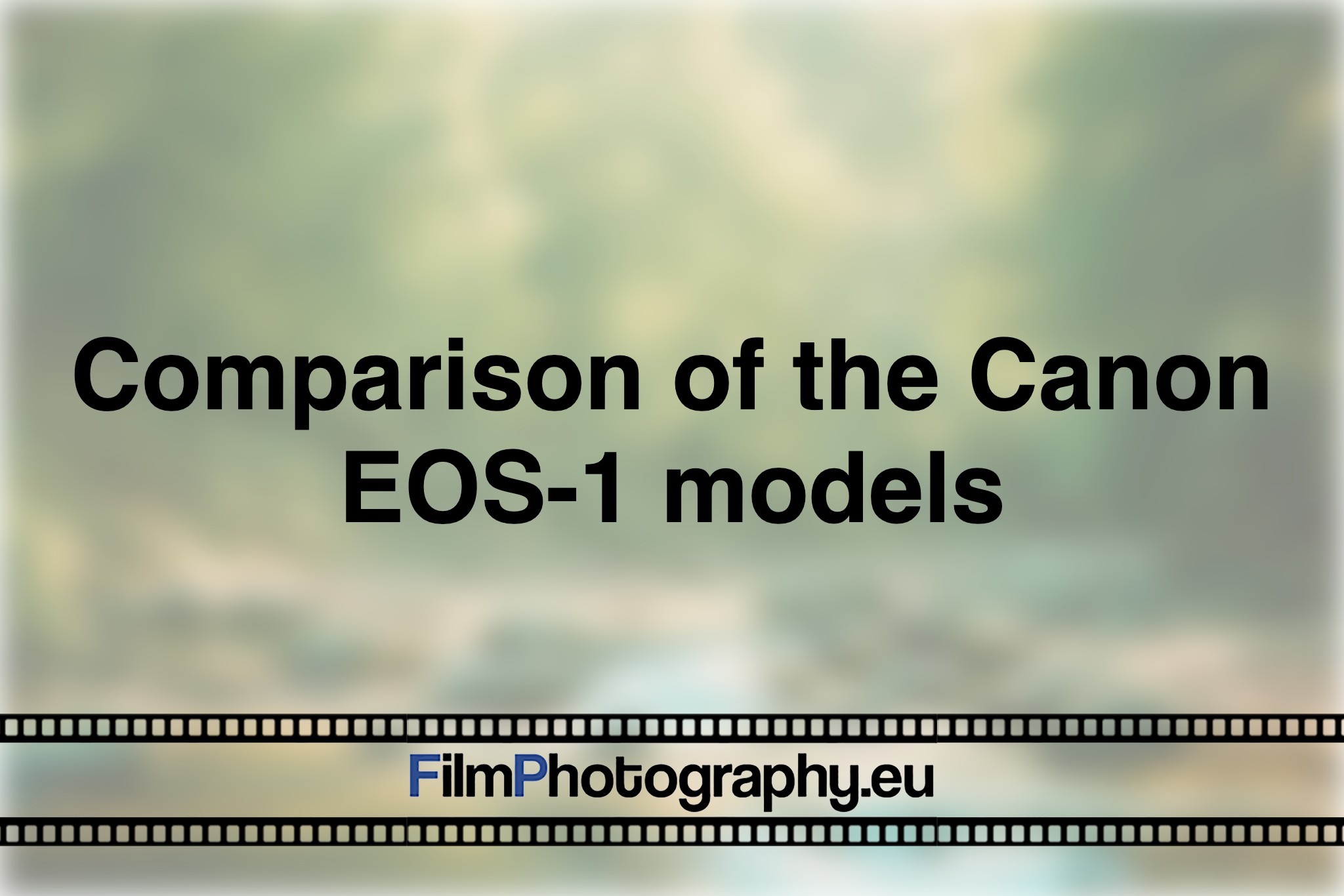How do Canon’s EOS-1 models differ?
The EOS-1 models are professional SLR cameras from Canon designed for use in press and sports photography. Although all four models share many similarities, there are also some differences between them.
| Canon EOS 1 | Canon EOS 1N | Canon EOS 1N RS | Canon EOS 1V | |
|---|---|---|---|---|
| Year of introduction | 1989 | 1994 | 1995 | 2000 |
| Film format | 35mm | 35mm | 35mm | 35mm |
| Original price (Body) | 189.000 Yen | 215.000 Yen | 320.000 Yen | 270.000 Yen |
| Lens mount | EF-Mount | EF-Mount | EF-Mount | EF-Mount |
| Exposure times | 1/8000 s bis 30 s | 1/8000 s bis 30 s | 1/8000 s bis 30 s | 1/8000 s bis 30 s |
| Bulb mode | Yes | Yes | Yes | Yes |
| Exposure meter area | 1 to 20 EV | 0 to 20 EV | 0 to 20 EV | 0 bis to EV |
| Exposure metering zone | 6 | 16 | 16 | 21 |
| Film sensitivity | ISO 6 to ISO 6400 | ISO 6 to ISO 6400 | ISO 6 to ISO 6400 | ISO 6 to ISO 6400 |
| Film sensitivity (DX) | ISO 25 to ISO 5000 | ISO 25 to ISO 5000 | ISO 25 to ISO 5000 | ISO 25 to ISO 5000 |
| Automatic Program Control | Yes | Yes | Yes | Yes |
| Aperture priority | Yes | Yes | Yes | Yes |
| Shutter priority | Yes | Yes | Yes | Yes |
| Manuel mode | Yes | Yes | Yes | Yes |
| Multi exposure | Yes | Yes | Yes | Yes |
| Self timer | Yes | Yes | Yes | Yes |
| Flash sync speed | 1/250 s | 1/250 s | 1/250 s | 1/250 s |
| Flash connection | Hot Shoe, PC-Flash-Connector | Hot Shoe, PC-Flash-Connector | Hot Shoe, PC-Flash-Connector | Hot Shoe, PC-Flash-Connector |
| Frames per second (regular) | up to 2,5 fps | up to 3 fps | up to 10 fps | up to 3 fps |
| Battery | one 2CR5 battery | one 2CR5 battery | eight AA batteries | one 2CR5 battery |
| Size | 16,1 x 10,7 x 7,2 cm | 16,1 x 11,2 x 7,2 cm | 16,1 x 16 x 78 cm | 16,1 x 12 x 7 cm |
| Weight | 850 gram | 855 gram | 1295 gram | 945 gram |
Canon EOS 1
The original model, the Canon EOS 1, was introduced in 1989 and was the first camera in the EOS 1 series. It has an EF bayonet and supports exposure times from 1/8000s to 30s. The camera has a program automatic, aperture priority, aperture priority, manual mode, multiple exposure function and self-timer. The flash connector is a hot shoe or PC flash socket, and the flash sync speed is 1/250 s. The camera weighs 850 grams and is powered by a 2CR5 battery.
Canon EOS 1N
The Canon EOS 1N was introduced in 1994 and is an evolution of the original model. It supports exposure times from 1/8000s to 30s and features program auto, aperture priority, shutter priority, manual mode, multiple exposure function and self-timer. The flash connector is a hot shoe or PC flash socket, and the flash sync speed is 1/250 s. The camera has an extended metering range of 0 to 20 EV and a metering zone of 16. The EOS 1N is slightly heavier than the original model, weighing 855 grams.
Canon EOS 1N RS
The Canon EOS 1N RS was introduced in 1995 and is an evolution of the EOS 1N. This camera also supports exposure times from 1/8000 s to 30 s and features programmed auto, aperture priority, shutter priority, manual mode, multiple exposure function and self-timer. The flash connector is a hot shoe or PC flash socket, and the flash sync speed is 1/250 s. The camera has an extended metering range of 0 to 20 EV and a metering zone of 16. What sets the EOS 1N RS apart from the other EOS 1 models is its high frame rate of up to 10 frames per second. It is also heavier than the previous model and runs on eight AA batteries.
Canon EOS-1V
The EOS-1V was the last model in the EOS-1 series and was introduced in 2000. It was also the most expensive model with a new price of 270,000 yen. Compared to the other models, the EOS-1V, has 21 light meter zone, which was also an expansion compared to the other models.
The EOS-1V also had a variety of features that made it a popular model with professional photographers. There was an expanded autofocus function with 45 AF points and improved multi-field metering.
In summary, Canon’s EOS-1 models have improved over time in terms of their technical specifications and features. All models are still very popular with many photographers due to their robust construction and ability to work in difficult conditions.
